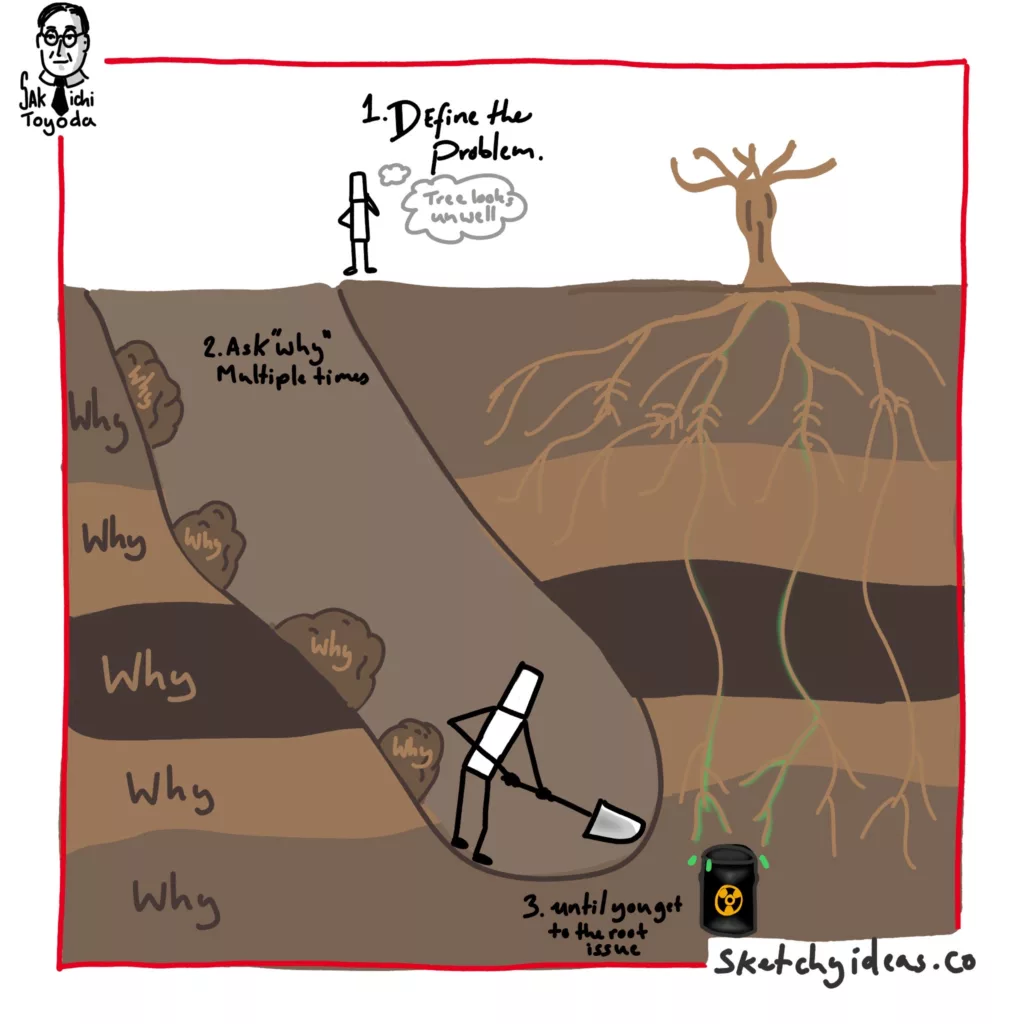Have you ever found yourself dealing with a recurring problem or facing a complex issue that seems impossible to solve?
When it happens, it’s easy to get overwhelmed and fall back into quick fixes. But these usually only address the surface-level issues. But what if there was a simple yet effective mental model that could help you dig deeper and uncover the root causes behind the challenges you face?
Enter the “5 Whys” technique, a powerful tool for problem-solving and uncovering hidden truths. Let’s explore what this mental model entails, why it matters, and how you can apply it to uncover the underlying causes of any problem.

Understanding the 5 Whys
The 5 Whys is a technique developed by Sakichi Toyoda, the founder of Toyota Industries, to identify the root cause of a problem by asking “why” multiple times. Recently, it’s been popularised by the lean startup.
The idea is to go beyond the surface-level symptoms and peel back the layers of causation until you reach the fundamental reason behind the issue.
Why It Matters
The 5 Whys technique helps us tackle root issues rather than treating surface symptoms.
This is far more effective as it stop symptoms reoccurring, prevents other symptoms we’re not aware of and is more comprehensive than just treating the surface issue.
By systematically asking “why” multiple times, we can uncover hidden connections, assumptions, and dependencies that contribute to the problem. It enables us to address the root cause rather than merely applying band-aid solutions.
Applying the 5 Whys in Practice
While the 5 whys is pretty obvious, there are a few little tips that can help you get the most out of the approach.
1. Define the problem
To get to the real root issue, make sure you have the right starting point.
You should get specific about the problem you need to address. Be specific and focus on a single issue at a time. This will put you in the right place to start your exploration.
For example, if your recent articles haven’t seen as much traffic as usual you don’t want to start with “Why isn’t our blog working any more” but “Why have our recent blog posts got X% less traffic from search and Y% less from social over the last 3 months?”
2. Ask “why” multiple times
Now, start asking “why” about the problem statement.
Once you have an answer, ask “why” again, linking it to the previous answer. Continue this iterative process until you reach a point where further questioning no longer provides meaningful insights.
Continuing our previous example, our first answer might be “The content is worse.” If we stopped there, we might just decide to “write better content” which isn’t very actionable. By asking why again, we can come up with criteria for how the latest articles are worse (maybe the topics weren’t as relevant, maybe they weren’t as well written, perhaps they were a different format) and use that to guide our correction.
3. Dig deeper
While asking “why,” don’t settle for the obvious answers and make sure your answers are correct.
Explore different angles, assumptions, and perspectives related to each “why” question. Uncover any hidden causes, underlying factors, or systemic issues that may contribute to the problem.
Again, in our blog example, it might be that our content is worse, but maybe there was a change in Google’s search algorithm so now our site gets less traffic. If that’s the case, we need to provide a very different treatment than if our writing is at fault.
4. Identify the root cause
By continuing to dig and question your answers, you’ll get to root cause.
Through the iterative questioning process, you will eventually arrive at the root cause of the problem. This is the underlying factor that, when addressed, can lead to a more sustainable and effective solution.
5. Take corrective action
Now you know the root cause, it’s time to take action.
Sometimes this is surprisingly simple as once you know the real issue, it’s simple to fix. But even when it does take some effort, it will be rewarded; by addressing the core issue you
Tackle the cause, not the symptoms
The 5 Whys technique is a simple technique to move beyond quick fixes and into solve hidden disruptions. All it takes is asking “why” multiple times and we can move beyond our natural, limited understand. So the next time a problem arises, try using the 5 whys technique for more effective solutions.

Leave a Reply